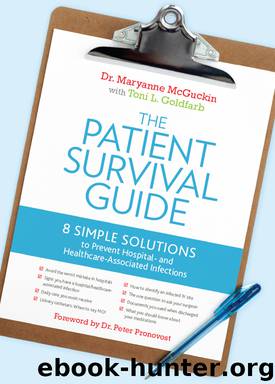The Patient Survival Guide by Toni L. Goldfarb

Author:Toni L. Goldfarb [51180]
Language: eng
Format: epub
Publisher: Springer Publishing Company
Published: 2012-02-16T00:00:00+00:00
* * *
Ventilator-Associated Pneumonia Does NOT Mean You're Deathly Sick
Studies show that many people recover, get removed from the ventilator, and are discharged from the hospital. Proper care is what makes this possible!
* * *
Q: What is the best way to prevent pneumonia when you're on a breathing machine?
A: Not needing mechanical ventilation for a long time is the best way to prevent ventilator-associated pneumonia, but that is often not possible. What is possible is early recognition of potential symptoms of pneumonia. You should be sure that your “vital signs” are checked every day. Are you developing a fever? Is there a decrease in the level of oxygen in your bloodstream (oxygenation)? Do you need more frequent suctioning of secretions? All these symptoms could be early signs of pneumonia.10
Speak up and let healthcare workers know if you notice these signs. Also ask if other ventilator patients in your hospital have been contracting pneumonia. That can be a clue that infections are going around. Be sure that your healthcare team reports these concerns to your doctor and lets you know what tests, treatments, or other procedures will be ordered. If no action is taken, be persistent. Patients and their loved ones are part of the healthcare team and should always be asking questions so that they can understand what's being done and question anything that does not seem right.
Q: Can antibiotics prevent ventilator-associated pneumonia?
A: Overuse of antibiotics should always be avoided because of the risk that pneumonia bacteria may become resistant to antibiotic treatment. However, guidelines from the American Thoracic Society and other infection control experts recommend starting “prompt, appropriate, and adequate therapy” with antibiotics if suspected pneumonia symptoms develop. If this is not done, it increases the patient's risk of dying.10 Similar guidelines from other professional groups like the American College of Chest Physicians say that antibiotic treatment should be started within 12 hours after first detecting symptoms that look like pneumonia.11
You know what it means to be empowered, so you or your advocate will need to use those skills to be sure you get good treatment. First, be sure that a sample of mucus from your lungs (“sputum”) is sent to a laboratory for examination to identify the specific kind of bacteria that may have infected your airways. Then the doctor can match the drug to the bug. Most hospitals gather data on current infections in their patients, at other local hospitals, and in the local community. These records indicate current levels of resistance within the community to certain antibiotics. Be sure that your doctor refers to this information to help select the right antibiotic that's most likely to work for you.10
Download
This site does not store any files on its server. We only index and link to content provided by other sites. Please contact the content providers to delete copyright contents if any and email us, we'll remove relevant links or contents immediately.
Good by S. Walden(3523)
The Social Psychology of Inequality by Unknown(2990)
0041152001443424520 .pdf by Unknown(2819)
The Checklist Manifesto by Atul Gawande(2812)
The Meaning of the Library by unknow(2537)
Get What's Yours for Medicare: Maximize Your Coverage, Minimize Your Costs by Philip Moeller(2380)
Guns, Germs and Steel by Diamond Jared(2338)
Borders by unknow(2281)
23:27 by H. L. Roberts(2223)
And the Band Played On by Randy Shilts(2169)
Being Mortal: Medicine and What Matters in the End by Atul Gawande(2093)
A Leg to Stand On by Oliver Sacks(2022)
The Hot Zone by Richard Preston(1996)
More Than Words (Sweet Lady Kisses) by Helen West(1840)
The Valachi Papers by Peter Maas(1830)
The Laws of Medicine by Siddhartha Mukherjee(1772)
The Andromeda Strain by Michael Crichton(1720)
The Obesity Epidemic by Robyn Toomath(1655)
Pharmacy Practice and The Law by Richard Abood(1558)
